ISSN ONLINE(2319-8753)PRINT(2347-6710)
ISSN ONLINE(2319-8753)PRINT(2347-6710)
Shadiya.K.P 1, Anjusha.R 2
|
| Related article at Pubmed, Scholar Google |
Visit for more related articles at International Journal of Innovative Research in Science, Engineering and Technology
Buckling restrained bracing systems are effectively being used to reduce seismic response during recent years. But often configurations of these systems are ignored while evaluating their behaviour. Aim of this study is to consider the effect of different bracing configurations on the behaviour of Buckling Restrained Braced Frames(BRBFs). Five-storey three-bay braced frames with three different patterns are modelled using Finite Element Analysis software ANSYS. The main variables of this study are the bracing pattern and location of bracing. The effects of bracing configurations on seismic behaviour of buckling restrained braces are also considered. The best combinations of bracing pattern and location along with specific bay width and storey height in terms of seismic response are suggested finally.
Keywords |
| Buckling Restrained Braced Frames, Bracing Configurations, Finite Element Analysis, ANSYS, Nonlinear Static Analysis, Von-Mises Stress. |
INTRODUCTION |
| The population all over the world is at an increasing pace, making it hard for the construction sector to find necessary land area for their projects. So the construction industries have now started preferring a compact design for their projects rather than constructing it over a vast area and thus it also contributes to the saving in land as well as materials. An important step towards this is the increasing trend for vertical growth of buildings. Skyscrapers and high rise buildings are the recent trends. Even though it’s a solution for the unavailability of land area, there arises an increased risk of seismic damage and the structures become susceptible to large seismic forces and lateral displacements and eventually collapse. To encounter this problem, ductility of the structure has to be increased and for that, different methods and techniques are brought into use among which bracing systems are the most efficiently used ones. There are different types and configurations of bracing systems effectively used till date. |
| Braced frames and moment frames are the most widely used framing system for steel construction in seismic regions. Compared to a moment frame, a braced frame offers high lateral stiffness for drift control. A braced frame can be broadly classified as a concentrically braced frame (CBF) or an eccentrically braced frame. Braces in a conventional CBF are expected to buckle and yield during a major seismic event. The conventional braces possess limited ductile capacity under cyclic loading and its hysteretic behaviour is unsymmetrical in tension and compression. The disadvantage of conventional CBF systems can be overcome if the brace can yield in both tension and compression without buckling. A CBF that incorporates this type of brace, i.e., buckling-restrained brace is called a bucklingrestrained braced frame (BRBF). |
| The concept of Buckling Restrained Braces was first introduced by Wakabayashi et al. [1] in 1973 who developed a system with steel flat plates sandwiched between a pair of precast concrete plates. Inoue et al. [2] performed a study on the plastic design of braced multi-storey steel frames. Redwood et al. [3] studied the effect of nonlinear behaviour of frames on ultimate forces which is transferred to column and braces. Jung-Han Yoo et al. [4] studied Analytical Performance Simulation of Special Concentrically Braced Frames. W.N.Duelkar et al. [5] studied the vibration control of structures using BRBs. Stephen Mahin et al. [6] studied the seismic performance of BRBs and dealt with their designs and applications. Nathalie Robert et al. [7] studied the seismic design and behaviour of Chevron steel braced frames and proposed height limitations for buildings in their paper. Javad Vaseghi Amiri et al. [8] studied the scope of using BRBs for seismic retrofitting. Rafael Sabelli [9] contributed to the development of seismic design procedure for Buckling Restrained Braces and codal provisions were developed which are incorporated in Steel construction manual of AISC [13]. Peyman Shademan Heidari, Roohollah Ahmady Jazany and Hossein Kayhani [10] studied the bracing configuration effect on Concentrically Braced Frames. Gary S.Prinz et al. [11] studied ductile topflange beam splices for improved buckling-restrained braced frame behaviour both experimentally and analytically. This study includes the nonlinear analysis of frames with Buckling Restrained Braces (BRBs) provided in different shapes and patterns. The effect of these changing configurations on behaviour of BRBFs is the area of interest here. The work in this paper is divided in two stages: 1) Modelling of the frames using CATIA 2) Finite Element Analysis using ANSYS. Thereafter, Von-Mises Stress and deformations are compared to identify the best bracing pattern and location against lateral forces. Finally, force deflection, stress-strain and strain-displacement graphs are obtained for various patterns after displacement controlled loading. |
| Paper is organized as follows: Section II explains the materials used for the modelling of the frames along with their properties and briefly explains the analysis methods used to evaluate nonlinear behaviour of the frames. Section III describes modelling of the frames and different bracing configurations and patterns adopted for the same. Section IV describes the method of analysis of the frames where Section V presents the analytical results obtained after the study. Final Section VI presents the conclusion. |
MATERIALS AND METHODS |
| Modelling of the braced frame structures was done using the CATIA V5 (Computer Aided Three-Dimensional Interactive Application Version 5) software which provides a multi-platform for the 3D designing and drafting of different structures and parts used in various industries including construction, automobile, aircraft design, etc. The method implemented by authors in [10] was validated and the results were found to be reliable so that it was adopted here. The frames were designed as per UBC97-LRFD [12] approach. The sections chosen for the beams and columns are European Parallel Flanged sections. IPE180 is used for columns and IPE140 for the beams. Welded angle connections were used to connect the beams and columns. The properties of these I-sections and angle sections correspond to ST52 steel grade. The bracing sections used are typical Buckling Restrained Braced (BRB) sections which consist of an inner steel core restrained by concrete and an outermost steel casing. The gusset plates used are triangular in shape to ensure their action as hinged connections. Properties of the bracing sections as well as gusset plates correspond to steel grade ST37. The base plates used at the end of columns are 30x60cm in size with 2cm thickness. |
| The material properties for gusset plates and bracing sections excluding the concrete region corresponds to ST37 with modulus of elasticity 1.96×10ïÿýïÿýN/mm2 and Poisson’s ratio 0.3 and its yield stress and ultimate stress are 225N/mm2 and 370N/mm2 respectively. Properties of the concrete region correspond to concrete with density 2300kg/m3 and Poisson’s ratio 0.18. The I-sections constituting beams and columns along with the angle sections as connections corresponds to ST52 with modulus of elasticity 2.1×10ïÿýïÿýN/mm2 and Poisson’s ratio 0.3 and the yield stress and ultimate stress are 345N/mm2 and 530N/mm2 respectively. The properties of base plate also correspond to that of ST52 steel grade. Analysis was done using the Workbench platform of ANSYS 14.5 Finite Element Analysis software. ANSYS simulation software, with its comprehensive multiphysics foundation, delivers efficiency and innovation to the product design and engineering process. ANSYS Workbench offers an easy and flexible platform to work with. Analysis method was followed after validating models from [10] and found the results to be satisfactory. Nonlinear static analysis was followed using displacement controlled loading at 0.1mm/sec. For finite element analysis of the models, 20-node SOLID186 elements were selected and the contact between the elements at connections was defined as bonded contact using the contact elements CONTA174 and TARGE170 which work together so well without any penetration. |
MODELLING OF THE FRAMES |
| A five-storey three-bay frame was selected and three different bracing patterns and locations were chosen. Frame was modelled at one-third scale with Bay width as 100cm and storey height as 82cm. Bracing patterns include single diagonal bracing, double diagonal (X) bracing and Chevron inverted V bracing. |
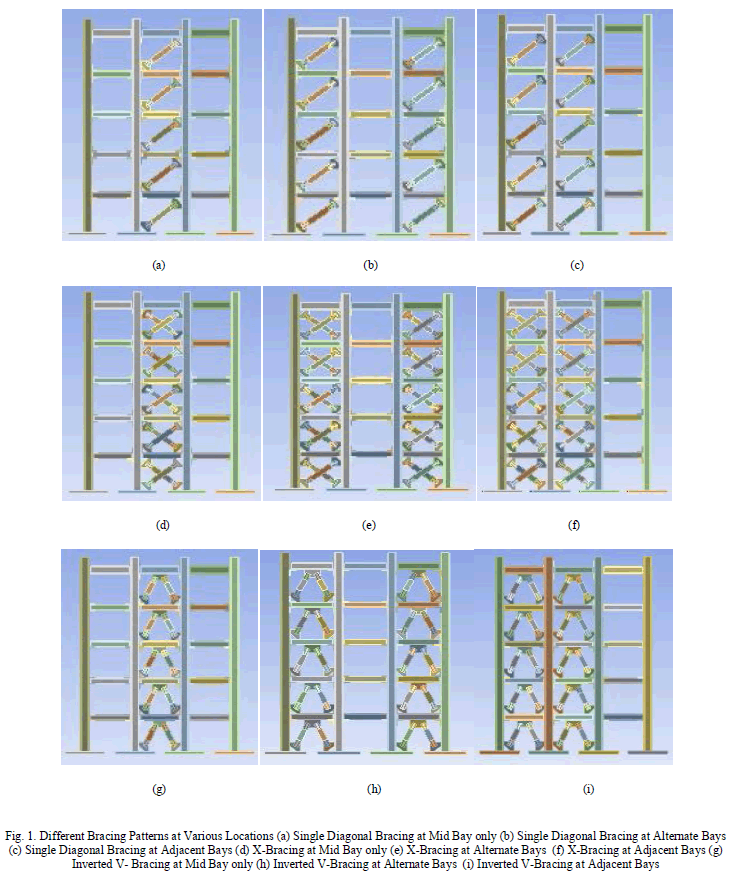 |
| Each type of bracing was varied in different locations like adjacent bays braced, alternate bays braced and mid bay only braced thus constituting a total of nine models. Fig. 1 shows different models of various types of bracings at three different locations. |
ANALYSIS OF THE FRAMES |
| Analysis was performed using ANSYS 14.5. Geometry was imported to ANSYS Workbench platform from CATIA. Boolean and slicing operations were done inorder to separate the steel core, concrete region and outer steel casing of the bracing section to assign the material properties separately. |
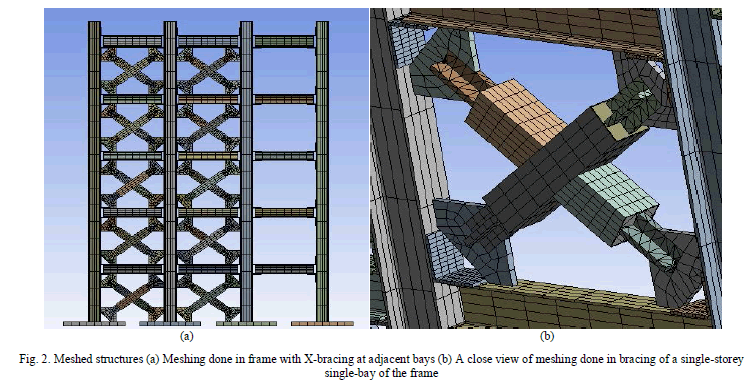 |
| Meshing was done using automatic sweep mesh method as shown in Fig. 2. Automatic sweep mesh in quadrilateral shape were used in sweepable regions like I-sections, and rectangular shaped mesh for outer steel casing of the bracing section as it has a regular geometry, triangular free mesh for inner steel core of the bracing and gusset plates and fine mesh was provided at contact regions such as for angle sections. and Fig. 3 shows the figure of loading. |
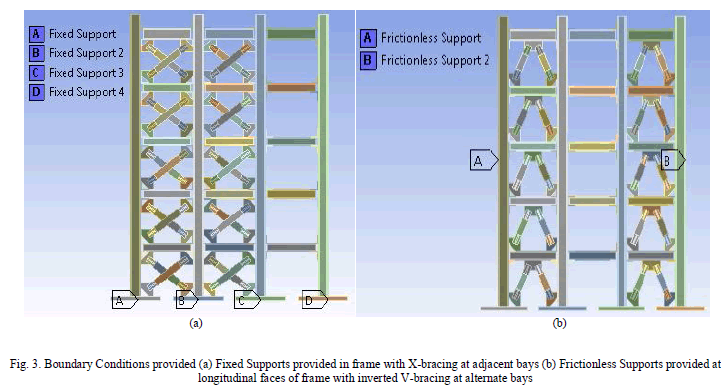 |
| Necessary boundary conditions and constraints were provided as shown in Fig. 3. Fixed supports were given at the end of columns. Frictionless supports were provided at the two longitudinal sides of the frames to restrict movement in longitudinal directions at the time of lateral forces. |
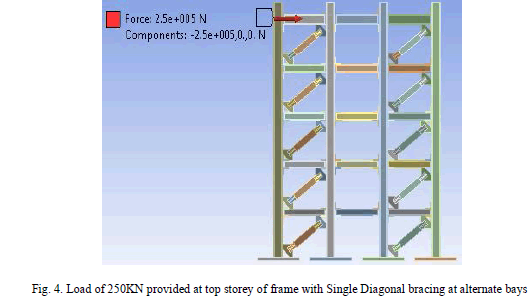 |
| Nonlinear static analysis was done by applying a displacement controlled loading of speed 0.1mm/sec. Fig. 4 shows the monotonic one-way loading of 250KN applied at the level of top beams. Total deformation of the frames subjected to lateral load and their Von-Mises stress patterns as well as strains were obtained after the analysis. |
ANALYTICAL RESULTS |
| Von-Mises stress values and total deformation for different models are tabulated and presented in Table. 1 below. |
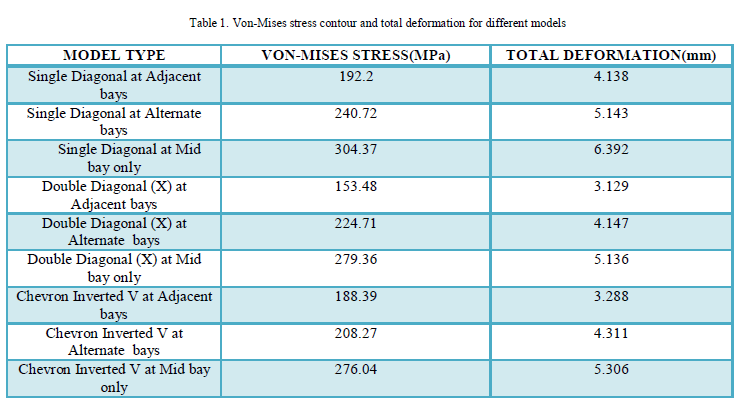 |
| Comparing stress and deformation of models after nonlinear static analysis, it was found that least stress and deformation was shown by frame with X-bracing at adjacent bays. |
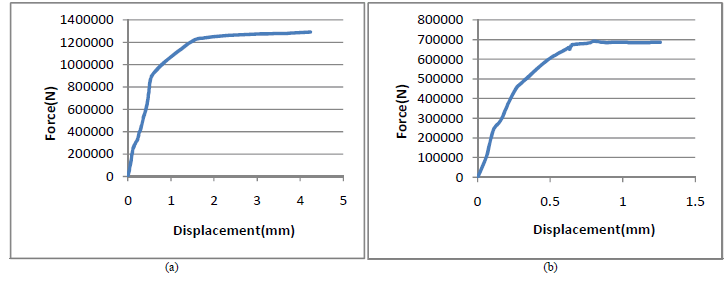 |
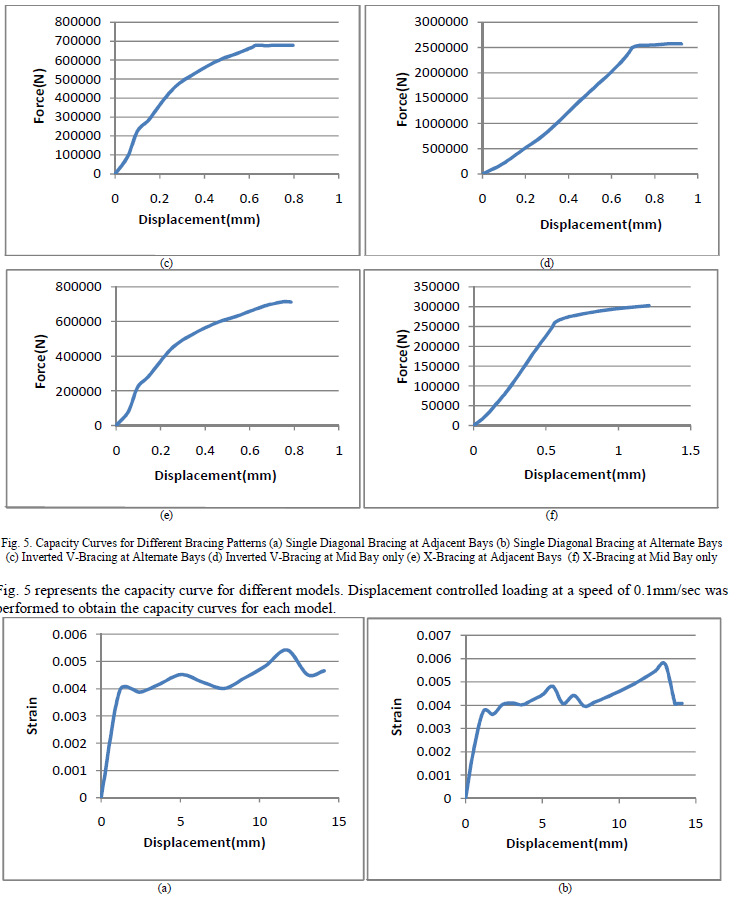 |
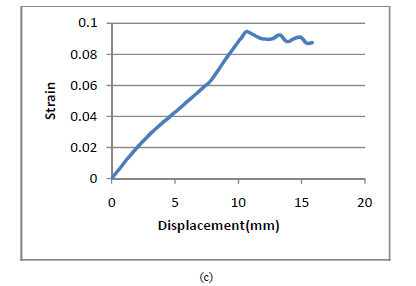 |
| Fig. 6. Strain- Displacement graph for (a) X-Bracing at Adjacent Bays (b) X-Bracing at Alternate Bays (c) X-Bracing at Mid Bay only |
| Strain-displacement graphs were obtained after analysis. Fig. 6 shows the strain-displacement graph for X-Bracing configuration at three different locations. |
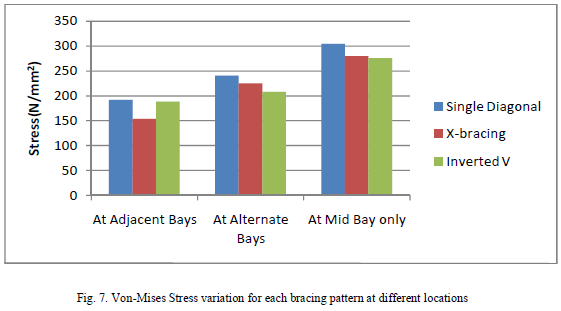 |
| Above Figures show the results of nonlinear static analysis of Buckling Restrained Braced Frames (BRBFs). Fig. 7 shows the stress variation in different bracing patterns at three different locations. From the comparison of results and graphs, it is found that the model with double diagonal bracing (X-bracing) at adjacent bays experience less stress and deformation under the applied loading condition. |
CONCLUSION |
| We have implemented a nonlinear static method of analysis to study the best bracing pattern and location for a frame braced with Buckling Restrained Braces (BRBs). The method was successfully implemented and the results extracted show that the model with double diagonal bracing (X-bracing) at adjacent bays experience less stress and deformation under the applied loading condition and so this bracing configuration can be used to resist seismic and other lateral forces most efficiently. The result can be justified with the fact that as there are more bracing elements, increase in their ultimate strength occurs and if they are located close to each other, there will be joint action which will resist large seismic forces, lateral displacements and storey drifts more effectively. |
References |
|